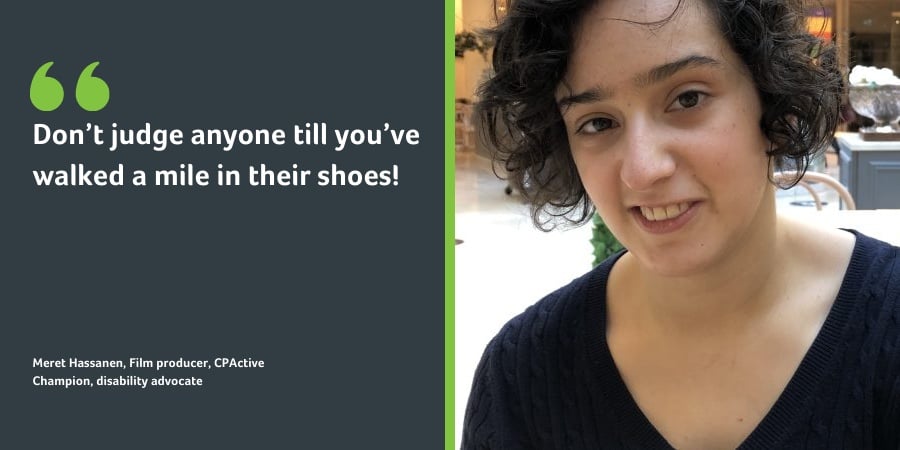
We welcome guest blogger, film producer, CPActive Champion, and disability advocate Meret Hassanen, Meret has cerebral palsy and shares insights on representation and inclusion from her recent presentation at the Fundraising Institute of Australia’s conference.
I was asked by Cerebral Palsy Alliance to present on Representation and Inclusion in the Charity Space at the Fundraising Institute of Australia’s annual conference. Liking a challenge and excited to travel to a favourite city, Melbourne, I said yes! However, with no experience in corporate fundraising, I knew a lot of research would be required. Here are some reflections on my presentation, which I delivered alongside CPActive Manager, Teigan Butchers.
I applied my work knowledge around representation and inclusion in film and TV, as well as my lived experience of cerebral palsy, to the presentation. I also used historical and current CPA fundraising examples, and drew on recent experiences with advocacy group CPActive, work projects from a few years ago, and concepts learnt at uni before that, to form persuasive arguments around representation and inclusion.

Meret Hassanen (pictured left) Teigan Butchers (pictured right)
Medical and social models of disability
One such example was the distinction between the medical and social models of disability. The terms, which I’d only come across in the last few years, describe two very different understandings of and approaches to disability.
The former used to be the most common understanding and treated disability as an individual problem, only to be fixed with medical intervention or institutionalisation. But with the Disability Rights Movement of the 1970’s came an outcry from advocates to change the system and treat people with disability the same as the rest of society. And so, the social model was born.
The social model approaches disability as being created by barriers in society, therefore an inaccessible society creates a disabling experience. Teigan had the perfect example of this for the presentation. She asked everyone to look around the room and observe how many people had glasses on.
Then she suggested that had glasses never been invented, everyone who required glasses would have a disabling experience because there’d be part of society that was inaccessible to them. It is such a simple construct — one I think that not only levels out the ‘physical access’ playing field, but has the potential to change social mindsets towards disability at large. After all, if society was truly accessible to everyone, there’d be no disability to speak of!
The language of disability
Language was another key theme in our presentation and can be closely linked to the different models of disability. We discussed how language can either confirm or deny inclusion depending on whether it was positive or negative. For example, certain terms that were common under the medical model, and shall not be repeated in this article, are now deemed offensive when talking about disability.
To demonstrate the impact of language, we used a case study that said: despite a person’s disability, they were able to work and study part time. Here, the word despite implies that the everyday tasks of work and study were considered extraordinary because the subject had physical disabilities.
Being seen and heard
Another example was attending the NDIS Jobs and Skills Forum in Canberra last year. The forum ensured that people with disabilities were included in discussions around the future of the NDIS and broader disability sector. We can compare this to how policies that are created without adequate consultation don’t properly support the groups they were intended to. Inclusion is vital in ensuring that targets are met and outcomes are beneficial to the community.
I also drew on experience filming a documentary with Angel Dixon OAM a few years ago and her work around inclusion in advertising campaigns. We finished our presentation with a powerful statement from Angel where she reflected on a campaign she did with an Australian retailer, which resulted in someone with disability approaching the retailer for employment as they’d seen Angel in the campaign. The positive flow on effects of representation and inclusion can further impact other areas of organisation and community.
So, I think it’s simple…when you want to make change, but don’t have any first-hand experience with the cause, consult the people who are most directly affected. A few sayings ring true here—never judge a book by its cover and don’t judge anyone till you’ve walked a mile in their shoes!